Freeze-Thaw Weathering and Degradation: The Effect on Road Pavements
Freeze-thaw weathering (also known as frost shattering) is a form of erosion that occurs when water enters porous rocks or permeable surfaces. As the water freezes, it expands, exerting pressure and this repeated cycle of freezing and thawing causes the cracks to widen resulting in fractures and degradation over time.
The effect of freeze-thaw weathering on asphalt surfacing has a major impact on pavement life, with each freezing event causing damage to the road pavement. The deeper influence of freeze-thaw weakening of the subgrade soil can bring about more rapid pavement failures, which is prevalent in regions where air temperatures rise and fall around zero for some time during winter or the shoulder seasons before and after winter.
In this blog, we explore what freeze-thaw weathering is, the mechanisms and types of damage caused by freeze-thaw cycles and the effects that a freeze-cycle can have on the subgrade which can cause major pavement damage.
We also look at how climate change is likely to increase susceptibility to freeze-thaw damage, and what part Tensar geogrids can play in increasing resiliency against the damage to pavements caused by freeze-thaw cycles.
Here for something specific? Use the links below to find what you're looking for:
- What is freeze-thaw weathering?
- What is a freeze-thaw cycle?
- The impact of climate change on freeze-thaw cycles
- How does freeze-thaw weathering damage asphalt?
- The impact of freeze-thaw cycles on subgrade soils and road foundations
- What is thaw weakening and how does it work?
- How Tensar solutions can help
If you are concerned about the potential effects of freeze-thaw weathering on an upcoming road construction project, speak to our team to understand how we can improve the longevity of the design whilst saving you time and money.
What is freeze-thaw weathering?
Freeze-thaw weathering is a type of erosion which happens in cold climates where ice forms. When water seeps into cracks or pores in rocks and soil particles and freezes. The expanding ice widens the cracks or forces apart the soil particles.
Freeze-thaw weathering is an example of mechanical weathering, also known as physical weathering. When considering the forces involved in frost shattering, it's easy to understand how this degradation process can happen. As water crystallises during freezing, the increase in volume is slightly more than 9% and the expansion pressures generated if confined can exceed 220 MPa: more than enough to fracture rock.
What is a freeze-thaw cycle?
A freeze-thaw cycle occurs when the air temperatures drop below zero allowing water to freeze. As air temperatures rise above zero this causes the ice to thaw. The phases of decreasing and increasing temperatures form a complete freeze-thaw cycle.
In the context of road surfaces and pavements, a freeze-thaw cycle will occur when water in the pavement freezes. During prolonged periods of sub-zero temperatures, this water will freeze at deeper depths, penetrating further into the subgrade soil beneath.
As air temperatures rise above zero, surface temperatures follow, causing the ice to thaw. The warmer temperatures slowly penetrate deeper into the pavement and soil beneath. This can cause cracking in the roads from the extreme temperature changes.
Where does freeze-thaw cycling occur?
Freeze-thaw cycling happens in near-polar regions, where air temperatures remain below zero for long periods. There may be just one seasonal freeze-thaw cycle per year. However, in Northern and Southern temperate zones, there are extended periods when air temperatures rise and fall between zero for days or weeks at a time. In these regions, there are multiple freeze-thaw cycles per year.
The impact of climate change on freeze-thaw cycles
An effect of climate change is that some near-polar regions in Canada, Northern Europe and Russia, which normally experience one long frigid season are experiencing more temperate conditions with multiple freeze-thaw cycles per year. Some regions that once had permafrost up to or close to ground level, now find that the permafrost has receded, resulting in subgrade soils and road foundations having to experience seasonal freeze-thaw cycles.
How does freeze-thaw weathering damage asphalt?
Freeze-thaw weathering affects asphalt at multiple levels, from microscopic changes to large-scale damage. Here's how freeze-thaw cycles impact asphalt through micro, mezzo, and macro effects.
Micro effects
Freeze-thaw cycles have been shown to cause damage to the binder, affecting its properties and causing a reduction in stiffness, compressive strength, and fatigue resistance of the asphalt concrete. The percentage of voids within the mineral aggregate increases under freeze-thaw cycling, further reducing the stability of the asphalt.
Mezzo effects
The presence of water freezing within the asphalt causes a reduction in the bond between binder and aggregate particles, this loss of adhesion referred to as ‘stripping’, continues under repeated freeze-thaw cycles.
Macro effects
Water entering the asphalt through cracks expands during the freeze phase, bursting apart the asphalt and widening and lengthening cracks. This reduces the structural performance of the asphalt layer and eventually leads to potholes forming. The potholes widen rapidly under the action of further freeze-thaw cycles.
The impact of freeze-thaw cycles on subgrade soils and road foundations
The adverse effects of freeze-thaw on road pavements can be divided into two separate but related processes: frost heave and thaw weakening. Frost heave is the upward movement of the pavement resulting from the expansion as water in the pavement layers and subgrade freezes. Thaw weakening describes the weakening effect on the subgrade resulting from soil saturation as ice within the subgrade melts.
What is frost heave and how does it work?
Frost heave is the formation of ice crystals within the larger voids between soil particles that extend to form continuous ice lenses. Ice lenses grow through capillary rise and they thicken in the direction of heat transfer until all water is frozen.
As water is frozen, a negative pore pressure develops in the pavement layers, which draws water upward from the lower unfrozen soil towards the frozen front: a phenomenon known as ‘cryosuction’. As the ice lenses thicken, the overlying soil and pavement layers ‘heave’ upward.
The longer sub-zero temperatures are maintained at the surface, the deeper the zone of frost penetration, the thicker the ice lenses and the greater the overall volume of frost heave.
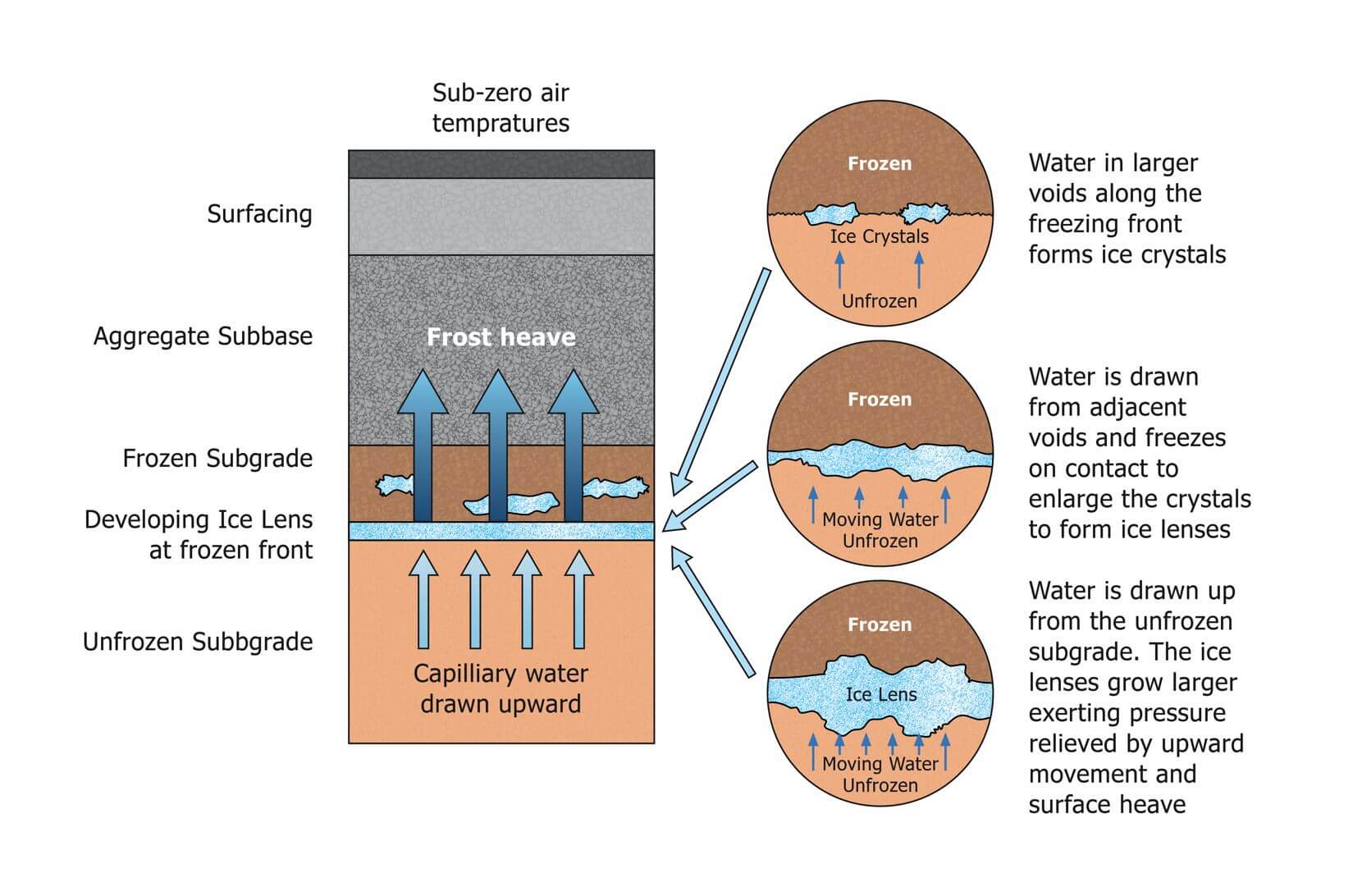
Figure 1 – The formation of ice lenses leading to frost heave
What are the conditions for frost heave?
For frost heave to occur, three conditions need to be met:
- The presence of materials which are frost susceptible. Many agencies chose to classify materials as being frost susceptible if 10% or more passes a 0.075 mm sieve or 3 percent or more passes a 0.02 mm sieve.
- Ground temperatures below zero degrees Celsius.
- The presence of water.
What is the effect of frost heave?
The upward non-uniform soil heave lifts the pavement and induces bending stresses in the asphalt layer which can result in cracking. This bending effect can be aggravated by the weight of snow ploughed onto the road edges. Pavement damage caused by frost heave is a major problem in countries that experience frigid winter conditions, particularly on low-volume roads with thinner asphalt layers.
Reduce maintenance requirements and enhance the service life of asphalt pavements with Tensar's asphalt interlayers.
Learn More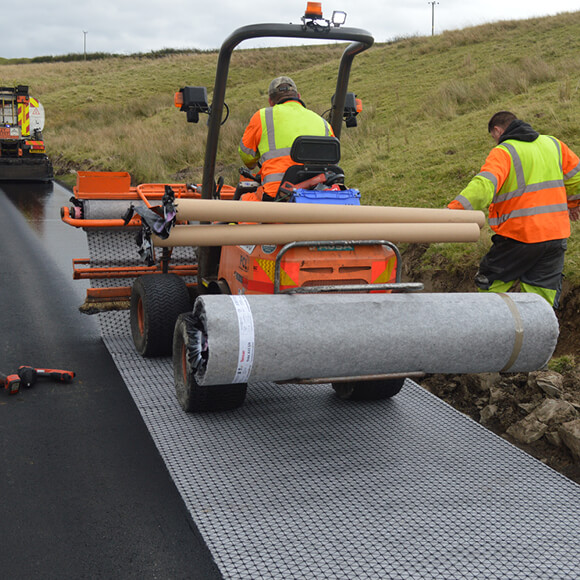
What is thaw weakening and how does it work?
In a sudden spring thaw, as air temperatures rise above zero, the temperature within the pavement begins to rise, commencing from the surface. A temperature gradient develops through the pavement, extending into the frozen subgrade. As the ice melts in the upper zone of the subgrade, the soil immediately below is still frozen and impermeable, water is trapped in the thawed soil layer. The saturated subgrade layer is substantially weakened and its bearing capacity is reduced. At this point, the pavement is highly susceptible to damage from traffic loading.
If there are several freeze-thaw cycles that extend to the subgrade, the effect is to loosen the upper subgrade soil, reducing density and stiffness. This then leads to even greater weakening after the final thaw takes place.
The 5 stages of thaw weakening
Illustrated below are the 5 stages of thaw weakening. The temperature gradient for each stage is superimposed over the pavement structure. After stage 5 the subgrade is in a very weak condition and the pavement is susceptible to failure under traffic loading. This can result in pavement cracking and severe surface rutting in roads.
Stage 1 - Frozen Pavement
The air temperature has remained below 0°C for an extended period. The subgrade is frozen down to the frost depth.
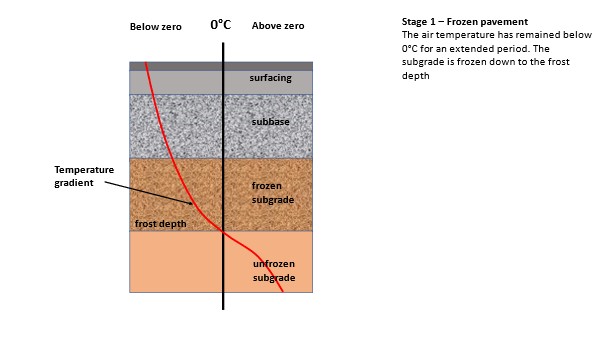
Stage 2 - First thawing
The air rises above 0°C. The pavement begins to warm from the surface downward. The upper subgrade thaws while the lower subgrade remains frozen down to the original frost depth.
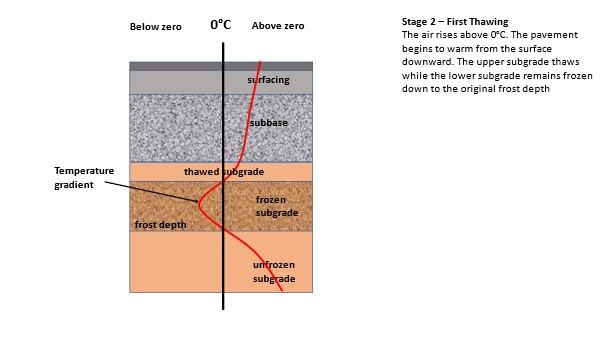
Stage 3 - Thaw weakening
Water from the melted ice is trapped in the thawed subgrade above the frozen subgrade zone, with only slow lateral drainage possible. The thawed subgrade is saturated and weakened with reduced bearing capacity.
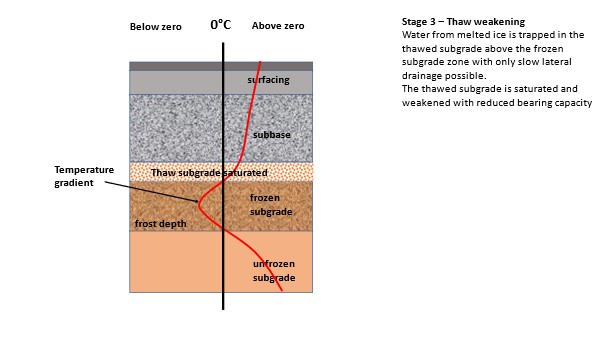
Stage 4 - Re-freezing
The air temperature drops again below zero. The pavement freezes down the frost depth. The saturated upper subgrade re-freezes and expands - loosening the soil particles.
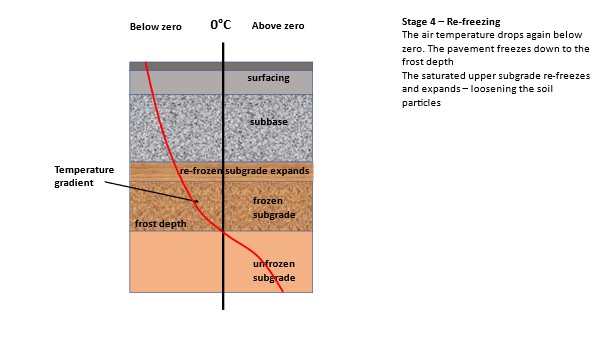
Stage 5 - Final thaw
After multiple freeze-thaw cycles, the temperature rises for the 'final thaw'. The thawed and saturated upper subgrade is now further weakened by dilation during freeze cycles. The pavement is now highly susceptible to damage from traffic loading in this thaw-weakened state.
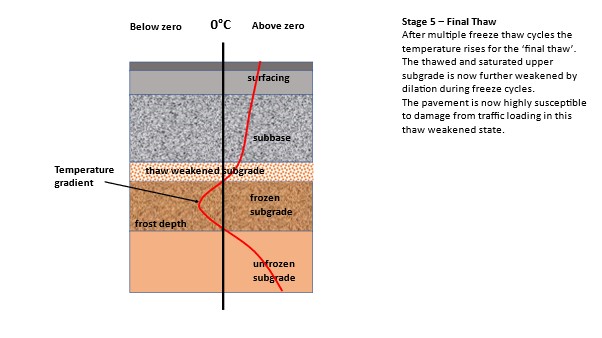
How Tensar solutions can help
Tensar has developed solutions that have been proven to tackle the pavement problems associated with freeze-thaw cycles in geotechnical engineering.
Building in resilience
By incorporating Tensar InterAx geogrid above the subgrade surface to stabilise the subbase layer in new construction, the pavement stiffness is increased and the weakened subgrade protected during the spring thaw period.
Reducing the cost of reconstruction
Where pavements have failed due to severe thaw weakening of the subgrade, Tensar InterAx geogrid can be incorporated into the reconstruction to avoid the need for deep excavation of weak subgrade soils.
Improving the life of asphalt overlays
Where pavement surfaces have cracked due to frost heave and an overlay is planned, Tensar asphalt reinforcement solutions can be employed to increase the life of the overlay by reinforcing the overlay to delay further cracking. Request a free design assessment to discover the value Tensar could add to your next project.
Next Steps
Found this article useful? You may also want to read:



.jpg?width=400&height=400&ext=.jpg)